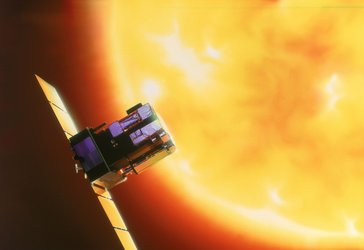SOHO's antenna anomaly: things are much better than expected
After a number of tests and new insights, SOHO engineers now say there will be no 'blackout' periods for SOHO science data.
High-rate transmissions from the Solar and Heliospheric Observatory (SOHO) were initially interrupted on 27 June 2003. The interruption was expected due to a recent malfunction in the pointing mechanism of the spacecraft's high-gain antenna (HGA). The loss of signal occurred on a 26-metre station of NASA’s Deep Space Network (DSN).
Until 30 June 2003, however, the spacecraft continued beaming down its science data, which were successfully picked up by larger 34-metre DSN stations (when available). In addition, dumping on-board recorder data during these contacts has further reduced data losses so far.
On 30 June 2003, the 70-metre DSN station in Madrid, Spain, successfully received high-rate science data through SOHO's omnidirectional on-board low-gain antenna. SOHO normally uses this antenna only for low-rate telemetry in emergencies, and the antenna does not need to be repointed.
Successful switch
Even better, when high-rate telemetry was lost on 1 July 2003, during a 34-metre station pass, engineers successfully switched SOHO into a medium-rate telemetry mode, using the low-gain antenna. In medium rate, all real-time science telemetry can be downlinked during station passes. However, on-board recorder dumps are not possible in this mode.
The relatively late occurrence of the initial loss of contact means that the effective SOHO's HGA antenna beam width is larger than anticipated. Also, since the 34-metre stations are much quieter than the smaller stations, you can use them for longer time periods than expected. Being able to transmit science data through the on-board low-gain antenna using 70- and 34-metre stations therefore means that there will be no hard blackout periods for SOHO science data, given sufficient ground station resources.
Minor losses
However, 34- and 70-metre stations are in higher demand than the 26-metre stations that SOHO normally relies on. Some data losses are therefore expected every day during the 2-3 week periods. "We're now talking only moderate fractions per day every day during the 2-3 week periods," says Bernhard Fleck, ESA’s SOHO Project Scientist.
SOHO scientists expect full high-rate telemetry coverage, even on 26-metre stations, to resume on or about 14 July 2003. To achieve this, they will make the spacecraft roll 180º around its Sun-pointing axis in a manoeuvre currently planned for 8 July 2003.
For more information, please contact:
Dr. Bernhard Fleck,
ESA SOHO Project Scientist
Tel: +1 301 286 4098
Fax: +1 301 286 0264
E-mail: bfleck@esa.nascom.nasa.gov





